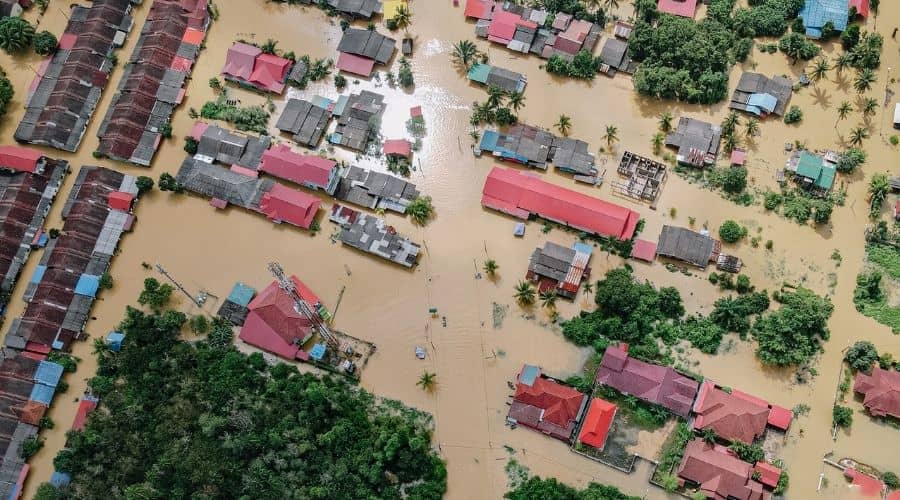
As the oceans swell up and sea levels rise, they threaten to swallow up the land that many of us call home. If we don’t stop this expansion, millions of people could lose their homes to flooding.
Education is the first step to taking action. When we know how and why the seas are rising and the impacts of this rise, we will have a better chance of preventing it. We hope these 17 facts about sea levels rising will make you even more determined to join the fight against global warming.
Statistics & Facts About Rising Sea Levels
1. Seas are rising faster than anticipated
Sea level rise is happening faster than scientists expected. This accelerated rise has made the collapse of the enormous West Antarctic Ice Sheet unstoppable.
2. Greenland is the single largest source of sea-level rise
Greenland is currently the single largest source of sea-level rise in the world. This large ice sheet covering nearly 80% of its land is melting at a record rate. Scientists believe that it could raise global sea levels by seven meters.
3. Miami could disappear entirely if Greenland melts completely
Sea level rise statistics indicate that Greenland could melt entirely in about 140 years. If this happens, Miami and most of Manhattan will disappear completely. Central London would be flooded. Bangkok, Bombay, and Shanghai would also lose most of their area.
4. The ocean is taking over coastal areas rapidly
Coastal areas currently home to more than 200 million people could be permanently below sea level by 2100.
5. Increasing sea levels are gulping up freshwater supply
As the ocean expands and takes up coastlines, the seawater can mix with groundwater supplies used to provide drinking water, making it unsafe to drink. This mixing of saltwater and freshwater could also damage water infrastructure and impact vital industries such as farming that rely on freshwater.
6. Food supplies are at risk too
As mentioned, farming is a vital industry that heavily relies on freshwater supply. The agricultural sector alone currently uses 70% of the world’s freshwater. If rising sea levels continue to interfere with the water supply, food supplies will be at high risk.
7. Stronger storms will become the norm
As ocean temperatures continue to warm and the seas will rise, leading to more dangerous storm surges. Coastal communities will be left to bear the consequences of wild weather events that could eventually wipe them out completely.
8. Rising sea levels increase biodiversity loss
The world is experiencing biodiversity loss at a worrying rate, and this could be made worse with rising sea levels. Coastal regions get affected as sea levels rise, yet they’re home to critical plant and animal species. Facts about sea levels rising show that 1 in 6 of the United States’ federally protected species is at risk of losing their habitats to sea-level rise.
9. Jakarta is the fastest sinking city in the world
Due to heavy groundwater use, Jakarta is subsiding on average from 1 to 15cm a year. Some coastal areas in Jakarta have already sunk between 3 to 4.1 meters.
10. Sea level rise could flood Thailand’s new parliament house in less than a decade
If a 10-year flood hits Bangkok in 2030, parts of Thailand’s new parliament house with a stunning gold stupa on top could be submerged from sea level rise and coastal flooding.
11. Metro Manila is sinking 10cm every year
Metro Manila, comprises 16 cities, including the City of Manila, and one municipality is sinking 10 cm every year due to over-extraction of groundwater. The sinking could worsen as sea levels rise and storm surges become more frequent and destructive.
Global Sea Level Rise Facts
12. Global sea levels have already risen by 8 inches since 1880
Global sea levels have gone up by 8 inches sing 1880. The levels are predicted to go up by another 6 to 10 inches by 2030 and 14 to 26 inches by 2050.
13. 216 million people worldwide could lose their homes
Global warming and sea level rise facts show that about 147 million to 216 million people worldwide could see their homes submerged or put at risk for regular flooding by 2100.
14. Global sea levels are worse in the 21st century
Sea levels are projected to rise faster during the 21st century than during the 20th century due to increased greenhouse gas emissions.
15. Oceans globally will rise by more than 90 centimeters by 2100
It’s projected that the oceans will rise by a global average of 28 to 61 centimeters by 2100 if greenhouse gas emissions are low and by 52 to 98 centimeters if emissions are high.
16. Global sea-level rise is costly
Rising sea levels could cost the world 14 trillion dollars a year by 2100 due to ruined real estate, destroyed infrastructure, and disrupted business supply chains.
17. Global flood damage could cost $1 trillion a year
Global sea level rise facts indicate that the average global food loss from flooding could rise to $1 trillion per year by 2050 if countries don’t take precautions.
What Is the Global Sea Level?
Sea level is the altitude where the ocean meets the atmosphere, which is noted as the average height of the sea.
How Fast Are Sea Levels Rising?
The global sea level has been rising at the global average rate of 3.6 mm per year (0.14 inches per year) over the last decade.
How Many People Will Be Affected by Sea Level Rise?
Rising sea levels facts indicate that up to 410 million people are at risk from high sea levels.
Did any of these 17 facts about sea level rising surprise you? That’s truly the grim reality. But here’s the good news: we can lessen these risks if we stop burning fossil fuels and preserve our forests.
You Might Also Like:
- How To Be More Eco Friendly
- Rising Sea Levels: What Are The Causes, Projections & Solutions?
- Fact About Ice Caps Melting
- Ocean Acidification Statistics

![]() Jamie - Cofounder
Jamie - Cofounder
Hi, I hope you enjoyed reading this article.
If you are looking for more ways to live an eco-conscious lifestyles, then check out our complete guide here.
Thanks for stopping by - Jamie


